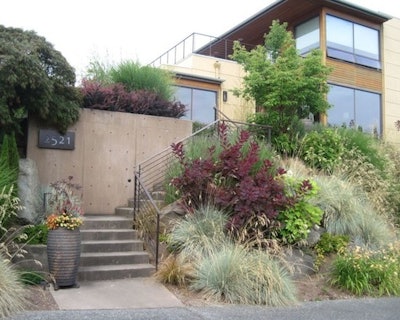
While swaths of a single plant variety can be peaceful in the landscape, there’s far more interest in a garden bed with a bit of diversity. If there’s a trick in choosing foliage to break up monotony, it’s proximity and contrast.
Related: Try These 10 Wildflowers to Create Unique Foliage
The more you can get a plant to stand out from its neighbors, the more your eye will be drawn to and delighted by it. As you choose foliage plants for your garden bed, remember these basic elements of landscape design: color, form and texture. Let’s see how creating contrast among these elements can have a stunning effect.
Creating Contrast
Color. When selecting foliage color, you practically have a rainbow of hues to choose from. For the most striking combinations in the bed, pair plants with contrasting foliage colors in close proximity. Blues and blue-greens have a cooling effect and can set off red, plum and magenta foliage placed close by. Silver, chartreuse and variegated foliage shimmer next to darker greens — particularly useful in brightening shady areas.
Form. Consider both the shape of the plant and the size and shape of its leaves. Beds made up of similarly sized plants with the same leaf shape can be fairly dull. For the most drama, mix plants with big, bold leaves with smaller-leaved perennials and ornamental grasses.
Texture. Just as important as color and form, the texture of a plant is determined by how it would feel to touch (or looks as though it would feel). Pairing plants with different textures in the planting bed makes each plant’s natural characteristics stand out. Some leaves, like those of camellia, are glossy and smooth, reflecting light almost as if they were lacquered. Others, such as lamb’s ears (Stachys byzantina), are covered in tiny protrusions, making them as soft and inviting as velvet. Cactuses offer no such temptation with their spikes and prickles.
Bold Forms With Fine Textures
Choose plants with bold, broad leaves — paperplant (Fatsia japonica), agaves, cardoons or phormiums — and pair them with light, wispy plants — sagebrush (Artemisia spp.), muhly grass (Muhlenbergia spp.) and ferns. The greater the contrast, the more the dramatic the display.
Along this dry streambed (see photo 3), bold-leaved hostas contrast with delicate conifer needles, ruffled purple coral bells (Heuchera sp.) and fine-textured bright green ‘Angelina’ stonecrop (Sedum rupestre ‘Angelina’). As the plants fill in and grow to maturity, the contrast among the coarse and fine textures will become more dramatic.
Deep Purple Foliage With Bright Silver Punctuations
Black, purple and deep burgundy leaves act as dark, moody foils for pale green, silver and golden leaves. For purple and burgundy, turn to smoke bush (Cotinus spp.), purple-leaved plums, black mondo grass (Ophiopogon planiscapus ‘Nigrescens’) and wine-colored ‘Plum Pudding’ coral bells (Heuchera ‘Plum Pudding’).
For silver and chartreuse foliage, golden creeping Jenny (Lysimachia nummularia ‘Aurea’), lamb’s ears (Stachys byzantina) and ‘Silver Falls’ dichondra (Dichondra argentea ‘Silver Falls’) are good options.
While the presence of either dark or light foliage breaks up the monotony of beds composed of all medium green, get the most drama by including both lights and darks in a single bed.
Here (photo 4), a golden smoke bush (Cotinus coggygria cv.) nearly glows behind a low stone wall, complemented by its deep purple cousin. A Japanese maple (Acer palmatum) balances the plum-colored foliage to the left of the patio. In the foreground, variegated ‘Silver Swan’ euphorbia (Euphorbia characias ‘Silver Swan’) forms a mound of silvery foliage among flower spikes of purple salvia.
All-Green With Varying Texture and Form
With all plants in the same shade of emerald green, this narrow side yard (photo 5) could potentially be monotonous. But mixing up the plant form and texture creates a stylish and visually engaging design. Succulent glossy rosettes of aeonium (Aeonium sp.) contrast with plume-like foxtail ferns (Asparagus densiflorus ‘Myers’) and the thin needles of fern pine (Podocarpus gracilior) hedging.
Contrasting leaf shapes and textures is another good way to add interest to beds with subtler variation in color. In the foreground of a primarily green shade garden (photo 6), the broad leaves of hostas and glossy bear’s breech (Acanthus mollis) stand out against the slender leaves of Japanese forest grass (Hakonechloa macra cv.). The purple leaves of coral bells (Heuchera sp.) deepen the color of the shadows.
You may choose to rely on color, form or texture — or a balance of all three elements — to create more contrast in your garden. However you go about it, keep in mind that there’s no wrong way to plant. Creating a garden that inspires and delights you is just as much about the process as the end result.

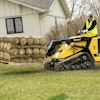
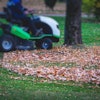


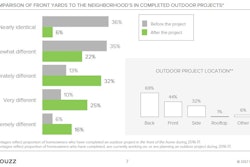



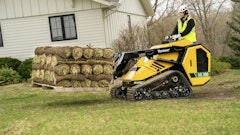






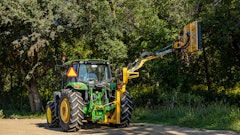
![T708 2025 Ga Tl11 R3 Hr [1 Q5 A1066]](https://img.greenindustrypros.com/mindful/acbm/workspaces/default/uploads/2025/10/t708-2025-ga-tl11r3-hr-1q5a1066.KcuUhTiF78.jpg?ar=16%3A9&auto=format%2Ccompress&fit=crop&h=135&q=70&w=240)

